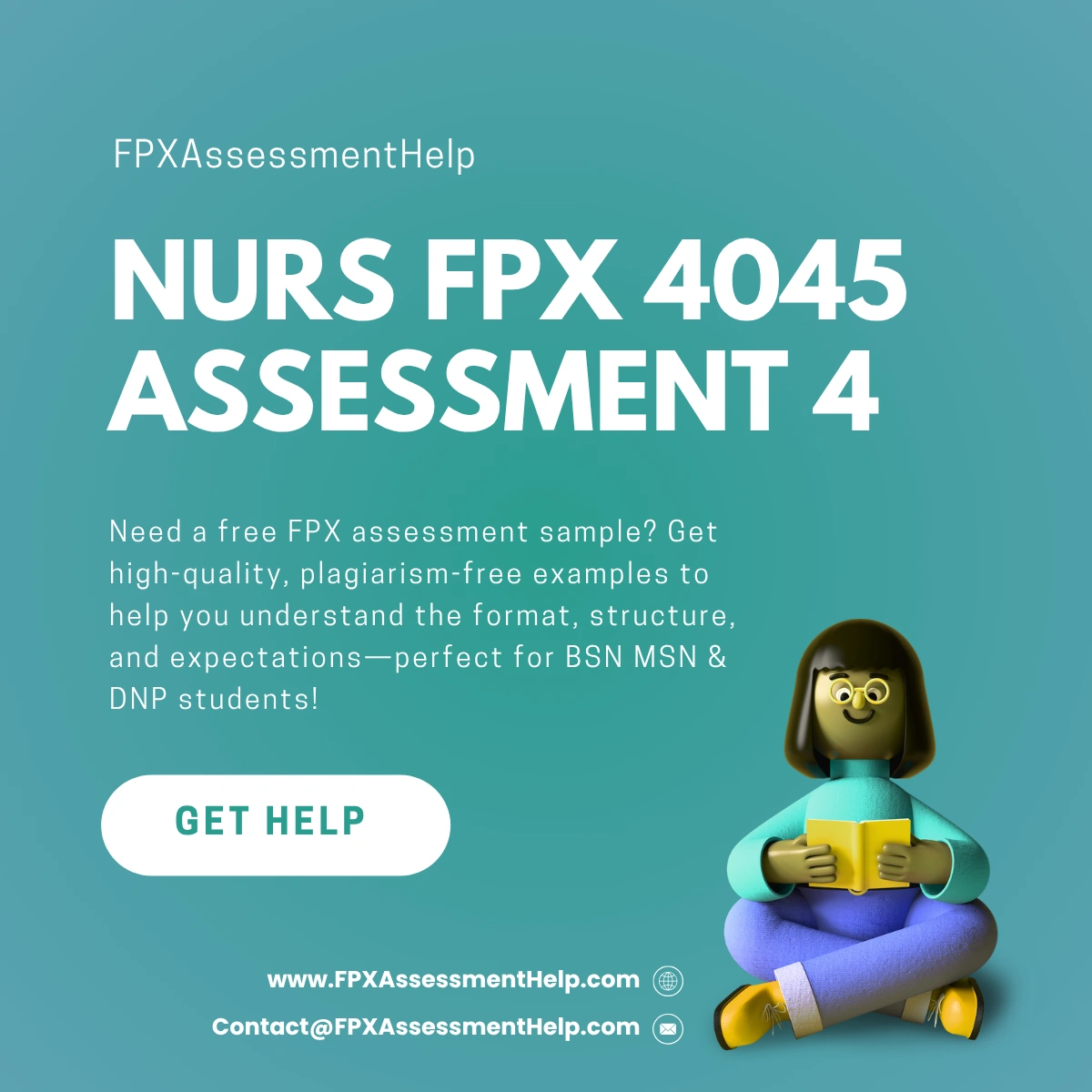NURS FPX 4045 Assessment 4 Informatics and Nursing-Sensitive Quality Indicators
Student Name
Capella University
NURS-FPX4045 Nursing Informatics: Managing Health Information and Technology
Prof. Name
Date
Informatics and Nursing-Sensitive Quality Indicators
Introduction: Nursing-Sensitive QI
Nursing-Sensitive Quality Indicators (NSQIs) are critical metrics reflecting how nursing care directly influences patient outcomes. Developed by the American Nurses Association (ANA), the National Database of Nursing-Sensitive Quality Indicators (NDNQI) collects and analyzes hospital-based nursing data across the United States to support quality benchmarking and drive improvements in care (Montalvo, 2020). This tool assists healthcare organizations in identifying care gaps and assessing how their performance aligns with national standards. The indicators focus on outcomes influenced by nursing, such as pressure ulcers, infection rates, staffing, and patient falls (Press Ganey, 2024).
This guide focuses specifically on the “Patient Falls with Injury” (PFI) indicator, a key metric encompassing both process and outcome dimensions. It not only monitors the frequency of patient falls but also evaluates whether injuries occur as a result, such as fractures or head trauma. This measure is particularly vital because falls represent a major cause of preventable harm in hospitalized populations, especially among adults aged 65 and older. Annually, over 14 million adults in this group fall, with around 9 million sustaining injuries, and over one-third requiring medical intervention (Centers for Disease Control and Prevention, 2024). Injuries from falls can significantly delay recovery, prolong hospitalization, and increase healthcare expenses.
New nurses must be familiar with PFI, as they are often the primary caregivers who can identify fall risks early. Understanding this indicator enables them to conduct timely assessments, utilize safety tools, and educate patients proactively (Li & Surineni, 2024). In doing so, they promote a culture of safety, accountability, and high-quality patient outcomes.
Gathering and Delivery of QI Data
Healthcare institutions employ several strategies for collecting data related to PFI. These include electronic health records (EHRs), real-time incident reporting, and observational methods. When a fall occurs, nurses are expected to document the event in detail, capturing the timing, location, nature of injury, and interventions taken. This documentation feeds into centralized databases that inform broader quality monitoring systems (Krakau et al., 2021). To ensure accuracy, quality assurance teams routinely perform audits and chart reviews.
Once compiled, fall data is shared internally via dashboards, scorecards, and reports that highlight trends and unit comparisons. These visual tools help nurse managers and staff track progress and benchmark their performance against national metrics like those from NDNQI (AHRQ, 2025). Reports are reviewed at regular intervals by hospital administrators and care teams to support transparency and engagement.
The nurse’s role in this data lifecycle is fundamental. Accurate documentation and thorough reporting form the basis of valid quality improvement (QI) analysis. For instance, failing to note safety interventions like non-slip footwear or proper patient assessments could distort data and undermine preventive strategies (Takase, 2022). Meticulous reporting ensures evidence-based improvements that enhance patient safety.
The data collection and dissemination process can be summarized in the table below:
| Step | Description |
|---|---|
| Data Collection | EHRs, incident reports, and real-time nurse documentation |
| Validation | Chart audits and reviews by quality assurance personnel |
| Data Aggregation | Centralized into reporting systems and categorized by severity |
| Internal Communication | Dashboards, reports, staff meetings, and training sessions |
| Benchmarking and Analysis | Compared against national standards like NDNQI for strategic interventions |
Multidisciplinary Team’s Part in Gathering and Recording QI Data
Effective fall prevention and PFI tracking involve coordinated efforts among various healthcare professionals, including nurses, physicians, therapists, risk managers, and IT specialists. Each team member plays a specific role in identifying risks, documenting incidents, and implementing interventions. Nurses, typically first on the scene, initiate reports and provide immediate care, while physicians treat injuries and therapists offer rehabilitation plans to mitigate future risk (Krakau et al., 2021).
Risk management teams further analyze the aggregated data to detect trends across units and evaluate systemic risks. Quality improvement (QI) professionals convert findings into actionable recommendations, updating policies as needed. Simultaneously, IT teams ensure reporting systems remain efficient and secure. Such collaboration enables healthcare teams to address environmental or procedural causes of falls—such as inadequate lighting or staffing—and develop targeted solutions (AHRQ, 2025).
The coordinated function of multidisciplinary teams strengthens fall prevention efforts and enhances the reliability of QI data. Clear communication among members allows for accurate documentation, identification of high-risk patients, and consistent application of fall prevention protocols. Collectively, this teamwork creates a culture of safety and improves care delivery for all patients.
Administration’s Input
Hospital leadership plays an instrumental role in leveraging NSQIs like PFI to shape care quality and strategic planning. Regular review of fall trends enables administrators to allocate resources effectively, such as increasing staff during vulnerable periods like night shifts or investing in safety technologies (Woltsche et al., 2022). The administration also ensures that performance metrics are disseminated across units to promote accountability and stimulate improvement.
Additionally, administrators support the integration of NSQI-driven practices into nursing workflows. Evidence-based protocols—such as routine fall risk assessments upon admission and consistent use of assistive devices—are incorporated into staff training and EHR templates. Tools such as electronic alerts, hourly rounding checklists, and visual cues like fall-risk wristbands are employed to reinforce these measures (Takase, 2022; Oner et al., 2020). These methods help standardize care, minimize variability, and reduce fall rates.
Ultimately, administrative endorsement of NSQIs fosters a quality-driven environment. When leadership prioritizes these indicators, it not only supports frontline staff but also ensures that clinical excellence remains a central goal.
Establishing Evidence-Based Practice Guidelines
NSQIs like PFI are foundational in creating evidence-based practice (EBP) guidelines that nurses use to ensure patient safety. By analyzing trends and risk factors from fall data, healthcare institutions develop robust care models. For example, the Morse Fall Scale is frequently used to evaluate fall risk at admission and throughout a patient’s stay, allowing personalized interventions based on risk scores (Mao et al., 2024). High-risk scores may activate automated orders for bed alarms, sensor-based footwear, or low beds within the EHR (Takase, 2022).
Another commonly applied strategy is visual identification of at-risk patients through colored wristbands or door signage. This alerts all members of the care team to take added precautions. It fosters a coordinated response where mobility assistance and close monitoring are prioritized (Boot et al., 2023). Such measures are simple but highly effective in reducing falls and improving patient confidence and comfort.
Through these interventions, guided by PFI data, organizations enhance patient experiences, reduce complications, and improve operational efficiency. EBP implementation, grounded in NSQIs, leads to measurable improvements in safety and patient satisfaction.
Conclusion
The Patient Falls with Injury (PFI) measure serves as a vital Nursing-Sensitive Quality Indicator that reflects both the efficacy of nursing care and the safety of the care environment. Data derived from this indicator informs evidence-based practices, promotes interdisciplinary collaboration, and drives organizational improvements. Nurses are key agents in preventing falls by utilizing assessment tools, documenting incidents thoroughly, and applying technology-supported interventions. Monitoring NSQIs like PFI ensures that healthcare systems remain responsive to safety challenges, enabling higher standards of care and better outcomes for patients.
References
AHRQ. (2025). Falls dashboard. Ahrq.gov. https://www.ahrq.gov/npsd/data/dashboard/falls.html
Boot, M., Allison, J., Maguire, J., & O’Driscoll, G. (2023). QI initiative to reduce the number of inpatient falls in an acute hospital trust. British Medical Journal Open Quality, 12(1), e002102. https://doi.org/10.1136/bmjoq-2022-002102
Centers for Disease Control and Prevention. (2024). Older adult falls data. Cdc.gov. https://www.cdc.gov/falls/data-research/index.html
Krakau, K., Andersson, H., Dahlin, Å. F., Egberg, L., Sterner, E., & Unbeck, M. (2021). Validation of nursing documentation regarding in-hospital falls: A cohort study. Biomed Central Nursing, 20(1). https://doi.org/10.1186/s12912-021-00577-4
Li, S., & Surineni, K. (2024). Falls in hospitalized patients and preventive strategies: A narrative review. The American Journal of Geriatric Psychiatry: Open Science, Education, and Practice, 5, 1–9. https://doi.org/10.1016/j.osep.2024.10.004
NURS FPX 4045 Assessment 4 Informatics and Nursing-Sensitive Quality Indicators
Mao, B., Jiang, H., Chen, Y., Wang, C., Liu, L., Gu, H., Shen, Y., & Zhou, P. (2024). Re-evaluating the Morse Fall Scale in obstetrics and gynecology wards and determining optimal cut-off scores for enhanced risk assessment: A retrospective survey. Public Library of Science, 19(9). https://doi.org/10.1371/journal.pone.0305735
Montalvo, I. (2020, September 30). The national database of nursing quality indicators. Ojin.nursingworld.org. https://ojin.nursingworld.org/table-of-contents/volume-12-2007/number-3-september-2007/nursing-quality-indicators/
Oner, B., Zengul, F. D., Oner, N., Ivankova, N. V., Karadag, A., & Patrician, P. A. (2020). Nursing‐sensitive indicators for nursing care: A systematic review (1997–2017). Nursing Open, 8(3), 1005–1022. https://doi.org/10.1002/nop2.654
Press Ganey. (2024). NDNQI. Pressganey.com. https://www.pressganey.com/platform/ndnqi/
Takase, M. (2022). Falls as the result of interplay between nurses, patient and the environment: Using text-mining to uncover how and why falls happen. International Journal of Nursing Sciences, 10(1), 30–37. https://doi.org/10.1016/j.ijnss.2022.12.003
Woltsche, R., Mullan, L., Wynter, K., & Rasmussen, B. (2022). Preventing patient falls overnight using video monitoring: A clinical evaluation. International Journal of Environmental Research and Public Health, 19(21). https://doi.org/10.3390/ijerph192113735





